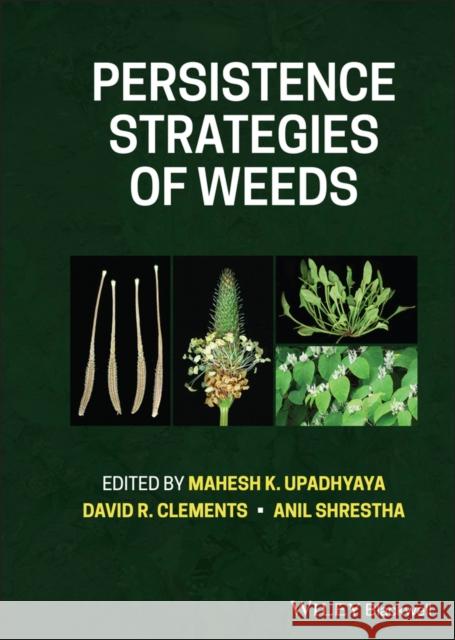Persistence Strategies of Weeds » książka



Persistence Strategies of Weeds
ISBN-13: 9781119525608 / Angielski / Twarda / 2022 / 400 str.
Persistence Strategies of Weeds
ISBN-13: 9781119525608 / Angielski / Twarda / 2022 / 400 str.
(netto: 780,56 VAT: 5%)
Najniższa cena z 30 dni: 698,66
ok. 30 dni roboczych
Bez gwarancji dostawy przed świętami
Darmowa dostawa!
1 Persistence strategies of weeds: IntroductionAnil Shrestha, David R. Clements, and Mahesh K. Upadhyaya1.1 Introduction1.2 Persistence of weeds1.3 Current approaches to managing weeds and persistence1.4 Conclusions1.5 References2 Seed production, dissemination, and weed seed banksAcácio Gonçalves Netto, Pedro Christoffoleti, Mark VanGessel, Saul Jorge Pinto de Carvalho, Marcelo Nicolai, and Caio Brunharo2.1 Introduction2.2 Seed production2.3 Seed dissemination2.4 Weed seedbank and seedbank dynamics2.5 Weed management and seed banks2.6 Use of chemicals to deplete soil seedbanks - Potential and limitations2.7 Weed seed destruction or devitalization of seeds2.8 Soil seed bank research methodology2.9 Conclusions2.10 References3 Weed seed dormancy and persistence of weedsMahesh K. Upadhyaya, Steve Adkins, and Li Ma3.1 Introduction - Seed dormancy and persistence of weeds3.2 Seed dormancy and germination3.3 Types of seed dormancy and some terminology3.4 Dormancy polymorphism3.5 Mechanisms of seed dormancy3.6 Co-adaptation of seed dormancy and hormonal regulation of seed reserve mobilization3.7 Duration of seed dormancy and depletion of seed banks during summer-fallow3.8 Dormancy cycling3.9 Conclusions3.10 References4 Seed dormancy genes and their associated adaptive traits underlie weed persistence: A case study in weedy riceXing-You Gu4.1 Introduction4.2 Weedy rice4.3 Genetics of primary seed dormancy4.4 Genes/QTLs responsible for associations of wild-like traits with seed dormancy4.5 Genes/QTLs responsible for associations of crop-mimic traits with seed dormancy4.6 Conclusions and implications4.7 References5 Environmental regulation of weed seed banks and seedling emergenceRoberto L. Benech-Arnold and Diego Batlla5.1 Introduction5.2 Germination5.3 Predation5.4 Loss of viability as a result of physiological deterioration5.5 Dormancy in seed banks and its control by the environment5.6 Germination as affected by temperature and water availability5.7 The functional ecology of weed seed banks: concluding remarks5.8 References6 Longevity of weed seeds in seedbanksAli A. Bajwa, Fernanda C. Beveridge, Mahesh Upadhyaya, and Steve W. Adkins6.1 Introduction6.2 Seeds and seedbanks as survival mechanisms6.3 Role of seed longevity in seedbank regulation6.4 Classical ecological experiments on weed seed longevity6.5 Factors affecting weed seed longevity6.6 Implications of seedbank longevity for weed management6.7 Conclusions and future research directions6.8 References7 Evolution and persistence of herbicide-resistance of weedsHugh J. Beckie, Linda M. Hall, Roberto Busi, and Michael B. Ashworth7.1 Introduction7.2 How evolution of herbicide resistance influences persistence of weed populations7.3 Case studies7.4 Conclusion7.5 References8 Seed predation and weed seed banksPavel Saska and Alois Honik8.1 Introduction8.2 Predators and seed predation windows in the life cycle of a weed8.3 Seed defence versus seed selection by predators8.4 Spatio-temporal variation in seed predation8.5 The significance of seed predation for the population dynamics of weeds8.6 Field and crop management effects on weed seed predation8.7 Methodological aspects of studying seed predation8.8 Directions for future research and conclusions8.9 References9 Modelling the persistence of weed populationsJonathan Storkey, Antoine Gardarin, Nathalie Colbach, Helen Metcalfe, and Alice Milne9.1. Why do we need models to predict weed persistence?9.2 'Broad-brush' ecological approaches to modelling weed persistence9.3 A process-based approach to modelling weed persistence9.4 Integrating seedbank processes into the multi-annual weed dynamics model9.5 The weed seed traits selected by management practices9.6 Conclusions9.7 References10 Influence of agronomic practices on the persistence of weed seedbanksClarence Swanton and Saeed Vazan10.1 Introduction10.2 Tillage: Vertical distribution of seeds within the weed seedbank influences weed seed persistence10.3 Light penetration and soil disturbance can reduce seed persistence10.4 Diverse crop rotations do not consistently reduce weed persistence10.5 Control of weed seed at harvest has potential to reduce seed persistence10.6 Role of cover crops and microbial populations10.7 Livestock, pasture and manure management can reduce weed seed persistence10.8 Conclusions10.9 References11 Clonal growth, resprouting, and vegetative propagation of weedsJitka Klimesová and Jana Martínková11.1 Introduction11.2 Weeding as a disturbance regime11.3 Plant strategies under recurrent disturbance11.4 Plant traits typical for tolerance strategies and resprouting limitations11.5 Tolerance strategy in an evolutionary perspective11.6 Conclusions11.7 References12 Climate change and the persistence of weedsDavid R. Clements and Antonio DiTommaso12.1 Introduction12.2 Weed ecophysiological responses to climate change12.3 Predicted changes in weed distribution12.4 Impacts of climate change on weed interactions with crops12.5 Evolutionary impacts of climate change on weeds12.6 Conclusions12.7 References13 Soil microbial effects on weed seed bank persistence: current knowledge and applications for weed managementMarkus Wagner and Nadine Mitschunas13.1 Introduction13.2 Mechanisms of microbial attack13.3 Abiotic environmental factors13.4 Biotic interactions13.5 Seed defences13.6 Weed management applications13.7 Future Prospects13.8 References14 The potential role of allelopathy in the persistence of invasive weedsSajid Latif, Saliya Gurusinghe, and Leslie A. Weston14.1 Introduction14.2 Classification of allelochemicals14.3 Allelochemical modes of action14.4 Synthesis, localization and release of allelochemicals from donor plants14.5 Factors affecting biosynthesis and release of allelochemicals14.6 The role of soil microorganisms in the release and transformation of allelochemicals14.7 Metabolic profiling of allelochemicals14.8 Case studies of invasive plant species exhibiting allelopathic interactions14.9 Conclusions14.10 References15 Weed adaptation as a driving force for weed persistence in agroecosystemsPaul Neve and Ana L. Caicedo15.1 Introduction15.2 Modes of weed evolution15.3 The genetic basis of phenotypic variation in weedy and fitness-related traits15.4 The contemporary evolution of weeds in agroecosystems: evidence and case-studies15.5 Applying evolutionary thinking to weed biology and management15.6 Weed adaptation: a key determinant of weed persistence in agroecosystems15.7 References16 Persistence strategies of weeds: Synopsis and the futureMahesh K. Upadhyaya, David R. Clements, and Anil Shrestha16.1 Introduction16.2 Weed propagation, dissemination and seed propagule banks16.3 Weed seed dormancy and longevity16.4 Agronomic practices16.5 Predation, microbial effects, and allelopathy16.6 Climate change and environmental influences16.7 Weed adaptation and evolution and persistence of herbicide-resistant weeds16.8 Modelling the persistence of weed populations16.9 Conclusions16.10 ReferencesIndex
Mahesh K. Upadhyaya, Professor Emeritus, Applied Biology, Faculty of Land and Food Systems, University of British Columbia, Vancouver, BC, CanadaDavid R. Clements, Professor, Biology and Assistant Dean, Faculty of Natural and Applied Sciences, Trinity Western University, Langley, BC, CanadaAnil Shrestha, Professor, Weed Science and Chair, Dept. of Viticulture and Enology, California State University, Fresno, CA, USA
1997-2025 DolnySlask.com Agencja Internetowa
KrainaKsiazek.PL - Księgarnia Internetowa









